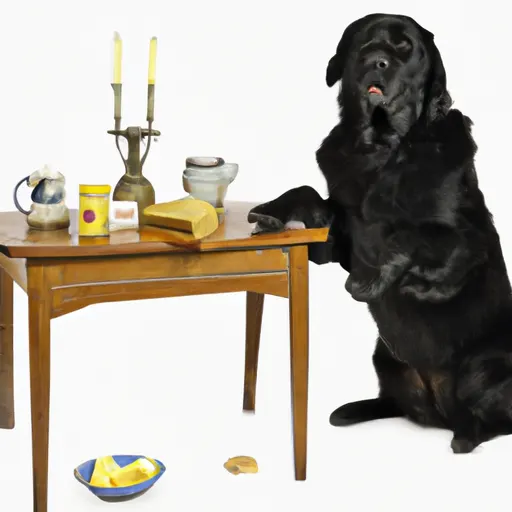This site is supported by our readers. We may earn a commission, at no cost to you, if you purchase through links.
We all love our furry friends and want to make sure they are healthy. But did you know that some of the foods we humans eat can be dangerous for them?
One food that people often wonder about is margarine. Can dogs eat margarine, or should it stay off their plate? In this article, we’ll answer your questions by exploring whether margarine is safe for dogs, what risks may come with feeding it to them and potential alternatives if you decide not to feed your dog margarine.
Let’s dive in!
Table Of Contents
Is Margarine Safe for Dogs?
 We wonder if margarine is safe for our furry friends. Margarine is made from vegetable oils and may contain artificial flavors, colors, and preservatives, making it unsuitable for homemade pet treats. The high fat content in margarine also makes it best to avoid feeding to dogs unless instructed otherwise by a veterinarian.
We wonder if margarine is safe for our furry friends. Margarine is made from vegetable oils and may contain artificial flavors, colors, and preservatives, making it unsuitable for homemade pet treats. The high fat content in margarine also makes it best to avoid feeding to dogs unless instructed otherwise by a veterinarian.
Instead, consider providing healthy fats like fish oil or natural peanut butter specifically designed for canine consumption.
Feeding margarine to dogs poses several risks, including upset dietary balance if consumed regularly. To ensure your pup’s safety, it’s important to carefully consider the ingredients in their food and treats.
Always consult with your veterinarian before making any changes to your dog’s diet.
Risks of Feeding Margarine to Dogs
We already know that butter is bad for dogs due to its high saturated fat and lack of nutritional value, but what about margarine? Margarine can also contain additives and preservatives not healthy for a dog’s diet.
So which one is worse when it comes to feeding our furry friends? That’s something we’ll explore in this discussion on the risks of feeding margarine to dogs.
Butter Vs. Margarine: Which is Worse?
We’re taking a look at butter vs. margarine to discover which is worse for our furry friends.
Butter contains saturated fat, while margarine has both trans fats and hydrogenated oils, making it the more dangerous of the two spreads when fed to dogs.
Trans fats are known carcinogens that can increase the risk of cancer in animals while increasing bad cholesterol levels and decreasing good cholesterol – all factors that can lead to heart disease in dogs if eaten long-term or even short-term in large amounts.
Additionally, many brands of margarine contain monoglycerides and emulsifiers as additives; these chemicals are not healthy for our canine companions either as they have been linked with digestive issues such obesity or pancreatitis due their high caloric content per serving size (even lower than what’s found in butter).
Therefore, it is safe to say that although neither spread should be given regularly nor generously portioned out due their lack nutritional value – from a health perspective alone, margarine poses more risks than butter does when feeding your pet companion.
Additives and Preservatives in Margarine
We strongly advise against feeding your furry friends margarine due to the dangerous additives and preservatives it often contains. These can potentially cause health issues for our beloved pets. Margarine is a non-dairy spread made from vegetable oils that are hydrogenated or partially hydrogenated, making them solid at room temperature and creating trans fatty acids in the product.
In addition to trans fats, these spreads typically contain artificial flavors and colors, as well as other unhealthy ingredients like sodium benzoate or polysorbates.
Therefore, we urge pet owners to avoid giving their pup any kind of margarine whatsoever. Instead, opt for healthier alternatives such as peanut butter with no added sugar or salt.
Can Dogs Eat Margarine?

Additionally, we will explore how much nutrition is available from giving a dog margarine as a treat or snack compared with other options.
Lactose Intolerance in Dogs
We understand that many of our beloved pets have lactose intolerances, so it’s important to be mindful when introducing new foods into their diets.
Margarine is typically made with oils and ingredients like dairy products which can cause digestive issues for dogs who are lactose intolerant. It also contains a high amount of fat content which could potentially lead to obesity if given in large amounts or too frequently.
Allergies may arise as well due to the presence of whey powder or other additives in margarine; symptoms include vomiting, diarrhea and abdominal pain among others. Therefore, it’s best not to feed your dog margarine at all since there are much healthier alternatives such as olive oil that contain healthy fats beneficial for your pup’s diet without any risk of allergies or digestion problems associated with margarine intake.
Nutritional Value of Margarine for Dogs
We don’t recommend margarine for our furry friends as it lacks essential nutrients and carries too many potential risks. Margarine is made from vegetable oils, such as soybean oil, which are hydrogenated to make them solid at room temperature.
This process creates trans fats that can be harmful if consumed in large amounts over a long period of time.
In addition, palm oil is often used in the production of margarine and this type of fat has been linked to an increased risk for obesity and diabetes when fed regularly to dogs.
Overall, while some people may think that giving their dog a bit of butter or margarine occasionally won’t hurt them; there really isn’t any nutritional value associated with these products so offering other healthier treats would be more beneficial overall for your pup’s well-being.
Alternatives to Margarine for Dogs

Plain white or wheat bread is also safe if given in small amounts, although it does not offer much nutritional value.
Unbuttered, Unsalted Popcorn
We’re happy to share that unbuttered, unsalted popcorn can make a tasty treat for our four-legged friends! Popcorn is an excellent source of dietary fiber and makes a great homemade dog treat.
It’s important to avoid any kernels that are still unpopped as these could damage their teeth or become choking hazards. Additionally, eating too much of the popped corn could cause intestinal blockage in some dogs.
If you’d like something more nutritious than popcorn but don’t want margarine, there are plenty of other healthy alternatives for your pup such as cooked vegetables, natural yogurt (without added sugar), unsweetened applesauce or low fat cheese which all make great treats without the unhealthy fats from butter-based products like margarine.
With so many options available now when it comes to finding snacks for your pup – both store bought and homemade – you’ll have no trouble coming up with something suitable even if they don’t enjoy plain white or wheat bread!
Plain White or Wheat Bread
We’ve got the scoop on plain white or wheat bread – it’s safe for your pup to enjoy in moderation, but doesn’t offer much nutritional value. Plain white and wheat bread have a few benefits when compared to other human food options.
They are both low in saturated fat, have no added preservatives like margarine does, and contain natural ingredients such as unsalted butter and peanut butter. Plus they contain nutrient-rich whole grains like rice flour that provide important vitamins necessary for dogs’ health.
Though these types of breads can be given to pups every once in a while as an occasional treat, they should not be confused with being part of their regular diet since there is limited nutritional value found within them:
- Unsalted Butter – Low-fat content; however, it may cause digestive issues if consumed by lactose intolerant dogs.
- Natural Peanut Butter – High protein source; contains sugar substitutes which could lead to obesity.
- Peanut Butter – Contains unhealthy fats that would quickly add up over time if ingested regularly.
- Plain Rice Flour – Nutrient-poor carbohydrate source.
- Wheat Flour – Has some dietary fiber but also has gluten which can cause allergies or sensitivities in certain breeds.
Overall, plain white or wheat bread is ok for your pup occasionally as long as you stick with small portions due to its lack of nutrition.
What to Do if Your Dog Eats Margarine

Be on the lookout for any changes in behavior or physical appearance such as vomiting or diarrhea – these can indicate an adverse reaction from consuming too much fat and additives contained in margarine products.
Contacting a Veterinarian
We should contact a veterinarian immediately if our pet has ingested margarine. Margarine contains additives and preservatives that can be dangerous for pets, so it’s important to get professional advice from an experienced vet as soon as possible.
Exercising pets is key to prevent accidental ingestion of harmful foods or substances like margarine, and pet food labels must always be read carefully before feeding anything new to your furry friend.
Veterinary visits are essential for the well-being of any pet, especially when it comes to administering pet vaccinations and other necessary medications; but in this case, we need quick advice on how best to handle the situation with our beloved animal companion who may have eaten something toxic such as margarine or butter.
Pet medication might also be prescribed by a veterinarian depending on the severity of symptoms related to ingesting these products – so again, don’t hesitate to call up your local vet right away!
Moving forward, we will discuss what symptoms to watch for after consuming food containing large amounts of fat like butter or margarine.
Symptoms to Watch for
Let’s take a look at the potential symptoms we should be aware of if our pet has ingested butter or margarine.
Diarrhea, vomiting, and/or abdominal pain are common reactions to dietary changes as well as possible allergic responses. It’s important to read labels when making any kind of dietary change for your pet and monitor their intake accordingly.
Additionally, it’s wise to keep an eye out for signs such as skin irritation or hives, which could indicate allergies in response to certain ingredients found in margarine like preservatives and additives.
With that said, monitoring how much they eat can help identify issues early on so that appropriate action can be taken quickly if needed.
Preventing Future Accidents
Let’s take proactive steps to prevent any future incidents by carefully reading labels, monitoring our pet’s intake of high-fat items, and keeping an eye out for signs of allergies or reactions.
We can start incorporating more raw vegetables into our dog’s diets as a healthy alternative to snacks loaded with butter or margarine. Also, look for low salt natural treats that don’t contain preservatives, which aren’t only unhealthy but also difficult to digest.
Adding digestive enzymes such as probiotics can help promote better digestion and regular bowel movements. While providing the correct balance of healthy fats like Omega 3 fatty acids into daily meals is essential in maintaining good health.
By taking these simple steps, we’ll be able to ensure the safety and well-being of our beloved canine companions!
Frequently Asked Questions (FAQs)
Can dogs eat butter instead of margarine?
We know that butter is bad for dogs, so it’s not a good idea to use butter instead of margarine. Butter has high saturated fat and little nutritional value, so giving your pup a slice of bread with butter on it can lead to numerous health issues.
A better option is homemade margarine made out of vegetable oil, olive oil, sunflower oil, or coconut oil. These options are much healthier and safer for your dog than salted or unsalted store-bought butter.
Keep in mind that treats should only be given in moderation – too many snacks could hurt your pup’s health!
Are there any health benefits to feeding margarine to dogs?
We all want the best for our dogs, so it’s important to understand that feeding margarine to them is not a health benefit. Margarine typically contains plant-based oils like soybean oil and palm kernel oil along with dairy-free spreads, natural sweeteners like xylitol or stevia, sunflower seeds, and other additives.
While some organic margarines may be healthier than others due to their lack of preservatives or artificial flavors, these are still unhealthy snacks for canines.
For this reason, it’s best avoided entirely when considering what treats you should give your dog.
Is there a difference between salted and unsalted margarine for dogs?
We’ve all heard that butter is bad for dogs due to its high saturated fat content and lack of nutritional value.
When it comes to salted versus unsalted, there isn’t much difference between the two when it comes to feeding them to your pup. Both types still contain fats and additives that are not beneficial for a dog’s health, so neither should be fed as a food source or used as substitutes in recipes.
However, if you do decide on giving your furry friend some margarine occasionally, make sure it is in small amounts with no added salt – too much could lead to digestive issues or even obesity from the extra fat content!
How much margarine can a dog eat without getting sick?
We all know that butter isn’t good for dogs, but what about margarine? It’s a low-fat alternative to butter and can be used as a substitute in recipes. However, it still contains hydrogenated oils which can cause digestive issues. Therefore, we recommend giving your dog no more than the occasional bite of margarine, if at all.
The high fat content of margarine makes it far from ideal and there are plenty of other healthier alternatives you could offer instead.
Is it safe to give a dog a slice of bread with margarine on it?
We have to be careful when it comes to giving our pups bread with margarine on it. Homemade margarine can contain artificial sweeteners, dairy products and other butter alternatives that are bad for dogs.
Vegetable oils used in most store-bought versions of this product are also not good for them either. Too much fat is unhealthy and can cause pancreatitis or numerous other health issues.
Even if you opt for the more popular store-bought version, there’s still a chance your pup could become sick from these ingredients. So take extra caution before feeding them any kind of bread with margarine on top.
Conclusion
At the end of the day, it’s best to avoid feeding your dog margarine altogether. Even though it’s not as bad as butter, it still contains additives and preservatives that can be unhealthy for your pup.
As the saying goes, an ounce of prevention is worth a pound of cure. Keeping your dog away from sugary and fatty spreads like margarine can save you a lot of hassle and heartache in the long run.
If you must feed your pup something buttery, there are healthier alternatives such as unbuttered, unsalted popcorn or plain white or wheat bread. It’s always best to check with your veterinarian before introducing any new foods or treats to your pet.






